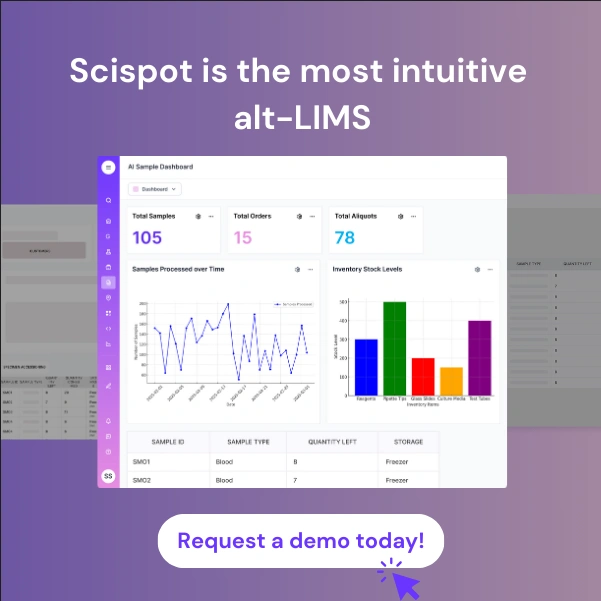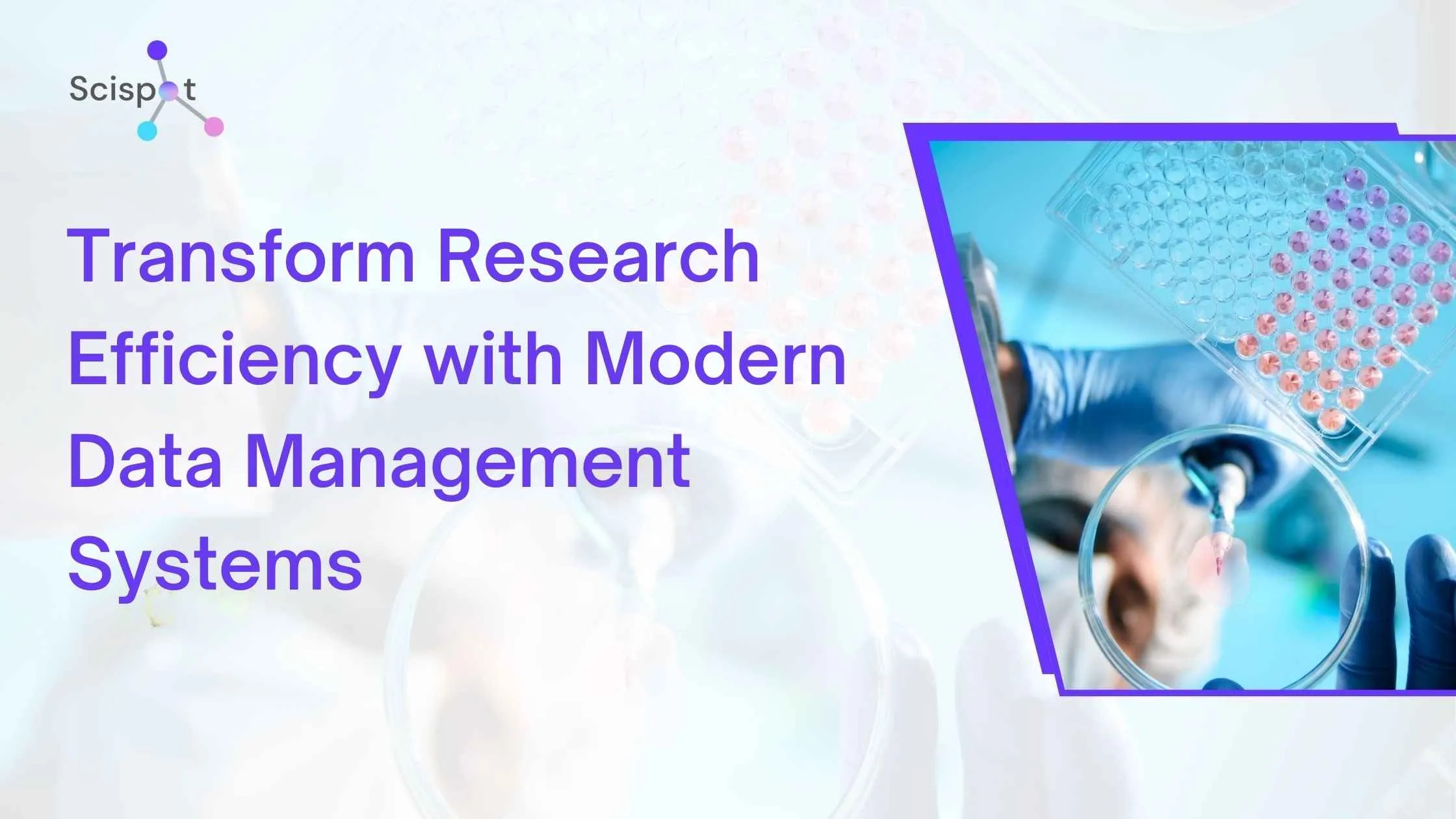Modern biotech laboratories face an unprecedented challenge: managing massive volumes of experimental data scattered across outdated systems. While research teams generate more data than ever before, many still rely on fragmented Excel files and manual processes that create bottlenecks, errors, and compliance risks.
Lab data management software has evolved from simple storage solutions into intelligent platforms that centralize, automate, and optimize research workflows. For biotech companies, pharmaceutical labs, and research institutions, the shift from traditional methods to modern centralized data management systems represents a fundamental transformation in how scientific discoveries happen.

The Hidden Costs of Fragmented Lab Data
Research teams typically waste 20-30% of their time managing data instead of conducting experiments. Scientists spend hours transferring results between systems, validating manually entered information, and searching for historical data across multiple platforms.
Traditional approaches create several critical problems. Data silos prevent teams from accessing complete experimental histories, leading to duplicated efforts and inconsistent results. Manual transcription introduces errors that can invalidate entire research studies. Without proper audit trails, labs struggle to meet regulatory requirements for FDA submissions or clinical trials.
Biotech startups particularly suffer from these inefficiencies. Limited resources mean every hour spent on data wrangling represents lost opportunities for breakthrough discoveries. As research teams grow, these problems multiply exponentially.

Why Centralized Systems Drive Research Success
Centralized data management eliminates information silos by creating a single source of truth for all laboratory activities. Instead of maintaining separate databases for samples, protocols, and results, modern platforms integrate everything into unified workflows.
Automated data capture reduces human error by directly connecting lab instruments to digital systems. When chromatography equipment, mass spectrometers, and other analytical tools automatically upload results, researchers can trust data integrity without manual verification steps.
Real-time collaboration becomes possible when entire research teams access the same updated information simultaneously. Principal investigators can monitor project progress, while lab technicians focus on experiments rather than administrative tasks.
Modern lab data management software like Scispot's LIMS platform demonstrates how integration transforms laboratory operations. By connecting instruments, inventory systems, and analysis tools, labs achieve seamless workflows that scale with research demands.

Ensuring Compliance Through Digital Traceability
Regulatory compliance requires detailed documentation of every experimental step, from sample collection through final analysis. Spreadsheet-based systems simply cannot provide the audit trails necessary for FDA validation or Good Laboratory Practice (GLP) standards.
Digital platforms create automatic timestamps, user signatures, and change logs that satisfy regulatory requirements. Every data modification gets recorded with complete context about who made changes, when they occurred, and why they were necessary.
Electronic lab notebook (ELN) systems enhance traceability by linking experimental protocols directly to results data. Researchers document procedures in standardized formats that integrate with downstream analysis tools, creating unbroken chains of evidence.
Scispot's ELN capabilities exemplify how modern platforms support compliance while improving research efficiency. Built-in validation workflows ensure data quality without slowing scientific progress.

Connecting Lab Instruments with Data Platforms
Instrument integration represents one of the most impactful advances in laboratory workflow automation. Instead of manually transferring results files, modern platforms establish direct connections that capture data automatically as experiments complete.
LIMS integration capabilities enable bidirectional communication between analytical instruments and laboratory databases. Sample information flows seamlessly from registration through analysis and reporting, eliminating transcription errors and reducing processing time.
Cloud-based architectures support remote instrument monitoring, allowing researchers to track experiment progress from anywhere. Real-time alerts notify teams when analyses complete or when equipment requires attention, optimizing instrument utilization.
Scispot's workflow automation demonstrates how integrated systems transform laboratory operations. Automated sample tracking, inventory management, and result processing free researchers to focus on scientific questions rather than administrative tasks.

Advancing Analytics Through Unified Visualization
Scattered data prevents researchers from identifying patterns and trends that drive scientific insights. Modern platforms consolidate information from multiple sources into interactive dashboards that reveal hidden relationships.
Advanced visualization tools enable researchers to explore multidimensional datasets through interactive charts, heat maps, and statistical models. Instead of exporting data to separate analysis packages, scientists can generate insights directly within their laboratory systems.
Machine learning algorithms identify anomalies and suggest optimizations that human analysis might miss. Predictive models help researchers design better experiments by learning from historical patterns and outcomes.

Embracing Cloud Solutions for Scalable Growth
Cloud-based lab data management software offers scalability advantages that on-premises systems cannot match. Research teams can expand storage and processing capacity instantly without hardware investments or IT complexity.
Security features in modern cloud platforms often exceed what individual laboratories can implement independently. Enterprise-grade encryption, backup systems, and access controls protect sensitive research data while enabling global collaboration.
Cost efficiency improves significantly when labs avoid hardware maintenance, software updates, and dedicated IT support. Subscription models align expenses with actual usage, making advanced capabilities accessible to organizations of all sizes.
Bridging Technology Gaps with Intuitive Interfaces
Successful adoption requires systems that feel familiar to researchers accustomed to spreadsheet-based workflows. Modern platforms provide Excel-like interfaces that reduce training requirements while adding powerful automation capabilities.
Programmatic access through APIs enables integration with existing analysis tools and custom applications. Research teams can leverage specialized software while maintaining centralized data management.
User-friendly design ensures that both experienced researchers and new team members can contribute effectively without extensive technical training.

Leveraging AI for Enhanced Research Insights
Artificial intelligence transforms raw data into actionable insights through automated analysis and pattern recognition. Lab data management software with built-in AI capabilities can identify experimental trends, suggest protocol optimizations, and predict likely outcomes.
Natural language processing enables researchers to query databases using simple questions rather than complex database commands. Scientists can ask "Which samples showed highest activity?" and receive instant, accurate responses.
Scispot's AI assistant exemplifies how intelligent systems augment human expertise. By automating routine analysis tasks, AI frees researchers to focus on creative problem-solving and strategic thinking.

Making the Transition to Modern Lab Management
Successful migration from legacy systems requires careful planning and phased implementation. Start by identifying the most critical pain points in current workflows, such as sample tracking bottlenecks or compliance documentation gaps.
Choose platforms that offer seamless integration with existing instruments and software. Data migration should preserve historical information while establishing new organizational standards for future research.
Train team members gradually, beginning with core functionalities before introducing advanced features. Successful adoption depends on user comfort and confidence with new systems.
Scispot's comprehensive platform provides the flexibility and support necessary for smooth transitions. From initial setup through ongoing optimization, dedicated account management ensures successful implementation.

Positioning Labs for Future Success
Modern biotech laboratories require centralized data management systems that support current research while adapting to future challenges. Integrated platforms eliminate inefficiencies, ensure compliance, and enable the collaborative science necessary for breakthrough discoveries.
Whether managing a startup research team or coordinating multi-site clinical studies, the right lab data management software transforms how science happens. By investing in modern platforms, laboratories position themselves for sustained success in an increasingly data-driven research environment.
The transition from fragmented systems to integrated platforms represents more than technological upgrade. It enables the collaborative, efficient, and compliant research practices that drive scientific innovation and business success.
Ready to transform your lab's data management capabilities? Book a free consultation to discover how modern platforms can streamline your research workflows and accelerate scientific discoveries.






.webp)
.webp)
.webp)



